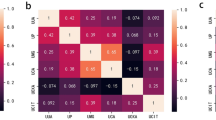Abstract
The secondary factors promoting formation of concrements are discussed. They result mainly from the incurable changes produced by the primary calculus as mechanical irritation of tissue, urinary retention and infection. According to data reported in literature, and based on the authors' examinations, it appears that the frequency of recurrent lithogenesis does not depend on the technique of operation used, but on the not eliminated infection of the urinary system. The lack of causalgenetic measures of treatment for patients suffering from lithiasis represents the cause for the quota of recurrent lithogenesis in 33.6% of the authors' cases. This fact warrants an intensive metaphylaxis of the patients suffering from lithiasis in order to improve the not yet satisfactory immediate and late results.
Similar content being viewed by others
References
Aberle, B.: Die Nierensteinkrankheit beim Kind.Urologe 7, 279 (1968).
Akkilic, M.: Unsere Ergebnisse der partiellen Nephrektomie bei Nierensteinen.Z. Urol. Nephrol. 58, 841 (1965).
Boeminghaus, H.: Urologie, operative Therapie, Klinik, Indikation. 2. Aufl. Edmund Banaschewski, München/Gräveling 1954.
Boeminghaus, H.: Diagnostische, klinische u. therapeutische Betrachtungen zum Harnleiterstein.Z. Urol. Nephrol. 54, 127 (1961).
Boshamer, K.: Morphologie der Harnsteine. In: Handbuch der Urologie, Bd. X. Springer, Berlin-Göttingen-Heidelberg 1961.
Büscher, H. H., Gaca, A.: Therapie der Nieren-u. Harnleitersteine. In: Handbuch der Urologie, Bd. X. Springer, Berlin-Göttingen-Heidelberg 1961.
Fuss, E. M., Schulz, H.: Nachuntersuchungen von 250 Fällen von Uretersteinen.Z. Urol. Nephrol. 26, 186 (1932).
Hasselbacher, K., Amthor, K. J., Kretschmer, K.: Die Beurteilung der Nierensteingefährdung.Zbl. Chir. 87, 961 (1962).
Hasselbacher, K.: Das Harnsteinleiden. 1. Aufl. Steinkopff, Dresden u. Leipzig 1966 (Med. Praxis Bd. 41).
Hellström, J.: Aetiologic and therapeutic experiences concerning kidney and ureteric stones.Brit. J. Urol. 21, 9 (1949).
Heuser, H.: Der Rezidivstein der Harnwege.Dtsch. med. Wschr. 83, 945 (1958).
Merényi, J., Wermer, T.: Klinische Betrachtungen bei 503 Uretersteinkranken.Z. Urol. Nephrol. 58, 15 (1965).
Papathanassiadis, S., Swinney, J.: Results of partial nephrectomy compared with pyelolithotomy and nephrolithotomy.Brit. J. Urol. 38, 403 (1966).
Peper, R.: Nierensteinbehandlung (Bericht über 850 Fälle).Z. Urol. Nephrol. 53, 593 (1960).
Pusinelli, W.: Plastische Eingriffe an Niere und Nierenbecken.Zbl. Chir. 86, 424 (1961).
Reuschel, F.: Katamnestische Untersuchungen u. klinische Beobachtungen bei Kindern mit Steinleiden. Med. Diss, Halle 1965.
Rockstroh, H.: Das Lebensschicksal der Einnierigen. Verlag Volk u. Gesundheit, Berlin 1967.
Staehler, W.: Nierensteinrückfälle, Entstehung, Wachstum, Verhütung.Z. Urol. Nephrol. 27, 624 (1933).
Staehler, W.: Klinik u. Praxis der Urologie. Bd. 1 u. 2, Thieme-Verlag, Stuttgart 1959.
Stewart, H. H.: The surgery of the kidney in the treatment of renal stone.Brit. J. Urol. 32, 392 (1960).
Sutherland, J. W.: Recurrence following operations for upper urinary tract stone.Brit. J. Urol. 26, 22 (1954).
Taubitz, A.: Über die Ergebnisse der Nierenteilresektion bei Urolithiasis mit besonderer Berücksichtigung der Steinpathogenese.Urologe 2, 219 (1963).
Thelen, A.: Weitere Erfahrungen mit der Polresektion bei Nierensteinen.Brun's Beitr. klin. Chir., 211, 147 (1965).
Voigt, W.: Über frühzeitige Rezidivierung von Nierenbeckensteinen.Z. Urol. Nephrol. 46, 723 (1953).
Volpjan, E. L.: Über Nierensteinrezidive nach operativen Eingriffen.Urologija i nefrologija 22, 4 (1957).
Williams, R. E.: Long-term survey of 538 patients with upper urinary tract stone.Brit. J. Urol. 35, 416 (1963).
Author information
Authors and Affiliations
Rights and permissions
About this article
Cite this article
Hofmann, W., Staude, G. Relapsing lithogenesis after operative treatment for calculus. International Urology and Nephrology 2, 337–341 (1970). https://doi.org/10.1007/BF02081689
Received:
Issue Date:
DOI: https://doi.org/10.1007/BF02081689




